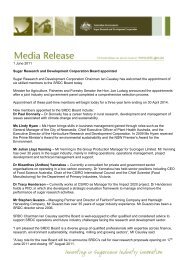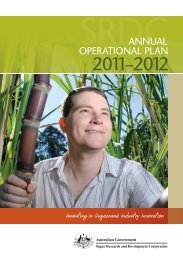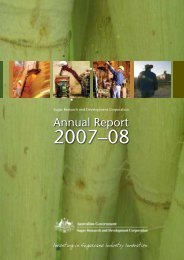Section 2 - Sugar Research and Development Corporation
Section 2 - Sugar Research and Development Corporation
Section 2 - Sugar Research and Development Corporation
You also want an ePaper? Increase the reach of your titles
YUMPU automatically turns print PDFs into web optimized ePapers that Google loves.
<strong>Section</strong> 1<br />
IMPACT OF SRDC INVESTMENT ON R&D OUTCOMES<br />
To remain competitive in world markets, industries must strive to world’s best<br />
practice <strong>and</strong> SRDC is pivotal in ensuring that the Australian sugar industry<br />
remains effi cient <strong>and</strong> sustainable while producing quality products dem<strong>and</strong>ed<br />
by the market.<br />
SRDC’s 20 year investment in sugarcane research<br />
<strong>and</strong> development (R&D) has provided Australia<br />
the ability to compete with emerging sugarcane<br />
industries <strong>and</strong> low production cost competitors<br />
such as Brazil.<br />
In mature industries such as cane sugar, quantum<br />
leaps in research innovation are comparatively<br />
rare. Nevertheless, there has been a considerable<br />
breakthrough in sugarcane production from R&D<br />
funded by SRDC over 20 years.<br />
Cane yields declined noticeably through the<br />
1980s as a result of long term cropping of the<br />
same l<strong>and</strong> to sugarcane – a comprehensive R&D<br />
program demonstrated the role of declining<br />
soil health under cane monoculture (physical<br />
<strong>and</strong> chemical deterioration of the soil; loss of<br />
benefi cial soil organisms <strong>and</strong> increase in pests<br />
<strong>and</strong> diseases of cane).<br />
A new farming system was developed that<br />
integrated minimum tillage, controlled traffi c<br />
<strong>and</strong> legume break crops with retention of all crop<br />
residues as surface cover. The better farming<br />
system has resulted in considerable cost savings,<br />
increased yields, improved pest <strong>and</strong> disease<br />
control, <strong>and</strong> improved environmental outcomes.<br />
Adoption of research outcomes across the<br />
Australian industry is rapid. In 2008, 2009 <strong>and</strong><br />
2010, Acil Tasman completed an independent<br />
benefi t cost analysis (BCA) of r<strong>and</strong>omly selected<br />
project outcomes funded by Rural <strong>Research</strong><br />
<strong>and</strong> <strong>Development</strong> <strong>Corporation</strong>s (RDCs). Results<br />
suggested the return on R&D investment was<br />
8:1 over the longer-term, which equates to<br />
increased returns for the whole industry in the<br />
order of $200m.<br />
Genetic improvement of the sugarcane plant is<br />
supported by SRDC through R&D investment<br />
to produce more cane varieties. Over the past<br />
decade, new cane varieties with high early<br />
Commercial Cane <strong>Sugar</strong> (CCS) content generated<br />
high returns <strong>and</strong> the net present value of the<br />
industry. For the past 20 years, SRDC funding<br />
of cane variety improvement projects has<br />
supported sugarcane yield growth, pest disease<br />
resistant varieties, <strong>and</strong> enabled the time taken<br />
to development of new cane varieties to be<br />
shortened to around three years.<br />
An SRDC funded project produced the world’s<br />
fi rst transgenic sugarcane plants in 1991–1992<br />
<strong>and</strong> there is ongoing R&D investment on gene<br />
technology to ensure our industry remains at<br />
the forefront of this new arena. Further R&D<br />
investigation of high CCS varieties with high<br />
biomass <strong>and</strong> disease <strong>and</strong> pest resistant species<br />
is aimed at signifi cant increases in sugar yield<br />
with concomitant reductions in costs of crop<br />
protection.<br />
SRDC frequently provides R&D funding for<br />
solutions to emerging challenges including<br />
declining CCS in far north Queensl<strong>and</strong>,<br />
sugarcane smut, orange rust, <strong>and</strong> outbreaks of<br />
cane grubs, weevil borers <strong>and</strong> cane-fi eld rats.<br />
This R&D is essential to maintain productivity –<br />
without this R&D investment the industry would<br />
decline <strong>and</strong> even cease to exist in some areas.<br />
Current R&D will better position the industry for<br />
climate change.<br />
SRDC has always balanced its responses to<br />
existing problems with funding to explore <strong>and</strong><br />
develop new opportunities. Precision agriculture<br />
is an R&D investment where signifi cant economic<br />
<strong>and</strong> environmental gains are likely, through<br />
increased effi ciencies <strong>and</strong> reduced inputs.<br />
SRDC recognises that industries that fail to<br />
respond to changing customer markets are likely<br />
to fail. To this end, several R&D projects focussed<br />
on Australian milling processes were successful<br />
to allow production of high pol raw sugar to<br />
compete with Brazilian sugar products. R&D<br />
has also helped mill areas supply <strong>and</strong> process<br />
sugarcane fi bre for generating electricity for<br />
export <strong>and</strong> for production of other products<br />
such as furfural.<br />
SRDC Annual Report 2010–2011 7






